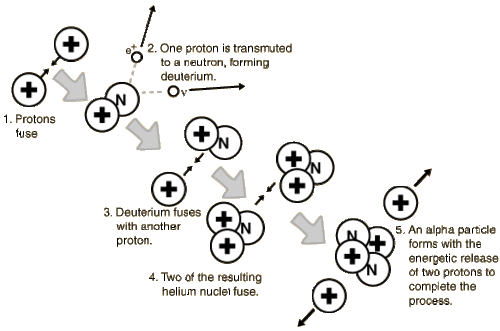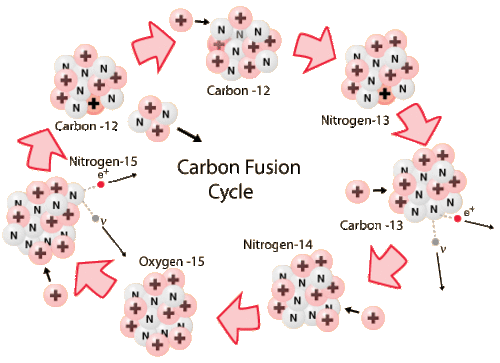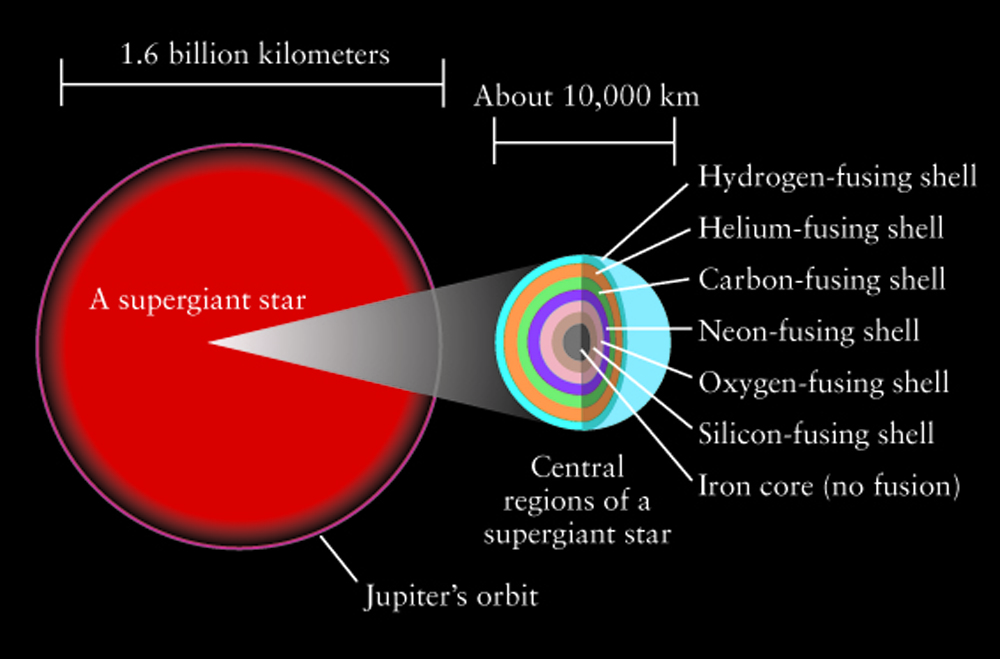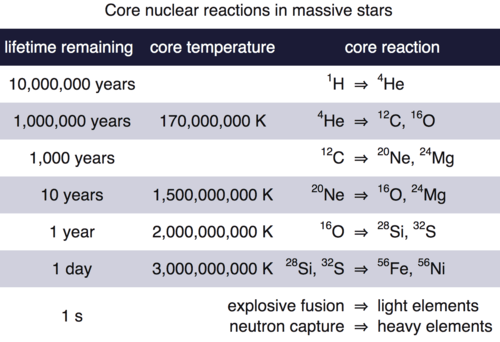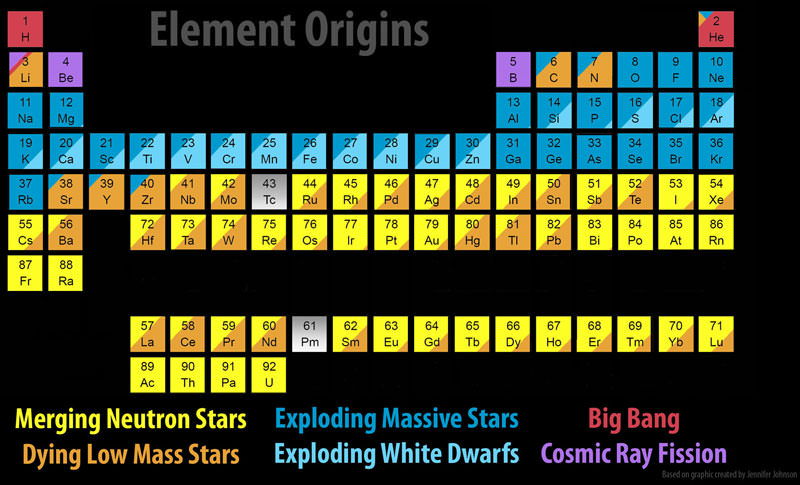3.2 定期表格
章节大纲
-
Overview
::概览概览概览概览概览概览概览概览Following the Big Bang, the only atomic elements that existed in the early universe were hydrogen, helium, and lithium. All other elements in the Periodic Table were formed later in the cores of stars. Since we need those other elements to form planets and life, we consider the process of star and planet formation and nucleosynthesis in this chapter.
Nucleosynthesis
::核循环合成Nucleosynthesis is the process of synthesizing heavier elements from lighter elements. In the Sun and other stars, the most common atom is hydrogen. It is possible for hydrogen nuclei (protons) to overcome the strong electrostatic repulsive forces because of the enormous temperature and pressure in the core of a star. The energy output of the Sun is 3.8 x 10 26 Joules per second (the energy per second is the luminosity of the Sun). This energy comes from the fusion of hydrogen into helium in the core of the Sun.
::核心合成是从较轻元素中合成较重元素的过程。 在太阳和其他恒星中,最常见的原子是氢。 氢核(质子)有可能克服恒星核心中巨大的温度和压力造成的强烈电静反动。 太阳的能量输出为每秒3.8 x 1026 焦耳( 能量每秒是太阳的光度)。 这种能量来自氢聚入太阳核心中的氦。H-fusion: the p-p chain
::H-聚聚:p-p链条The exact pathway for nucleosynthesis is very temperature-dependent. In a star like the Sun (or less massive than the Sun), the process is proton-proton (or p-p) fusion and follows the steps outlined in the below.
::核子合成的确切路径非常依赖温度。 在像太阳这样的恒星中( 或比太阳小得多) , 过程是质子- 质子( 或 p- p) 聚变, 并遵循下面描述的步骤 。The p-p chain for hydrogen fusion. In addition to making helium, this process of nucleosynthesis produces the energy that supports the Sun against collapse. One reaction cycle in the p-p chain produces 25 MeV of energy. In the second step of the p-p chain, a proton is transformed into a neutron. How does that happen?
::氢聚变的 p-p 链条。除了制造氦外,核循环合成过程还产生支撑太阳反崩塌的能量。p-p 链条中的一种反应循环产生25兆瓦的能量。在p-p 链条的第二步,质子被转化成中子。这如何发生呢?How many hydrogen nuclei are needed to produce a helium nucleus?
::生产氦核需要多少氢核?A few things to know.
::有一些事情需要知道。First : Recall that the hydrogen nucleus is simply a proton, and the helium nucleus (also called an alpha particle) has two protons and two neutrons.
::第一:回顾氢核只是一个质子, 核(也称为α粒子)有两个质子和两个中子。Second : protons and neutrons are not fundamental particles, they are comprised of a soup of quarks, anti-quarks, gluons - their nature, a fascinating tale of quantum mechanics, is being explored a particle accelerators like the Large Hadron Collider ( ). Protons have two "Up" and one "Down" quark, while neutrons have one "Up" and two "Down" quarks. By using a bit of energy to transmute the spin of one "Up" quark, a proton can change into a neutron. This is a statistically rare process, but there are a lot of protons and a lot of energy in the core of the Sun.
::第二:质子和中子不是基本粒子,它们由夸克汤、反夸克、格伦斯组成,它们的性质、量子力学的奇妙故事,正在探索一个粒子加速器,如大型强子相撞机 () 。 质子有两个“ 上” 和一个“ 下” 夸克, 而中子有一个“ 上” 和两个“ 下” 夸克。 通过使用一点能量将一个“ 上” 夸克的旋转成中子, 质子可以转换成中子。 这是一个统计上罕见的过程, 但太阳的核心有很多质子和大量能量。Take a look at the above to see how many protons (a.k.a. hydrogen nuclei) are needed to build one helium nucleus. Importantly, the mass of the helium nucleus is less than the mass of the 4 protons. T hat mass difference is converted into the energy that is radiated by the Sun.
::看一下上面, 看看需要多少质子( a.k.a. 氢核) 来构建一个核。 重要的是, 核的质量小于 4 质子的质量。 质子的质子差异被转换成太阳辐射的能量 。In the first step of p-p nucleosynthesis , a small fraction of hydrogen transforms into deuterium (an isotope of hydrogen with a neutron added to the nucleus). This is the rate-limiting step in the p-p chain because the transformation of a proton into a neutron is statistically improbable. Once deuterium is created, the rest of the p-p pathway proceeds relatively quickly.
::在 p-p 核核子合成的第一个步骤中,一小部分氢会转化成(氢同位素同位素,核中加入一个中子 ) 。 这是p-p 链条中的限速步骤, 因为质子转换成中子在统计学上是不可能做到的。 一旦锂形成, p-p路径的其余部分会相对快速进行。As hydrogen fusion occurs in the Sun, most of the mass of the hydrogen is converted into an "ash" of helium. However, there is a slight difference of 0.71% between the mass of 4 protons and the mass of a helium nucleus; this fraction of the original mass is converted into energy and the mass loss rate from the Sun, , can be calculated with Einstein's famous equation:
::随着氢聚变在太阳中发生,氢的多数质量被转换成的“ash”。然而,4个质子的质量与氦核的质量之间有0.71%的微小差别;原始质量的这一部分被转换成能量,而太阳的质量损耗率,m,可以用爱因斯坦的著名方程式计算:[Eqn 2]
::mc2E=3.8×1026Joulesc=3×108ms2 [英吋 2]The mass that is converted into energy every second is:
::每秒转换为能量的质量如下:
::m=EC2=4x109千克=440万吨Think about that... every second, 4.4 million tons (or 4.4 billion kg) of the mass of our Sun vanishes - it is transformed into energy that is radiated away. However, this represents only 0.71% of the mass of hydrogen that is converted into helium. How much hydrogen is being burned in the sun every second?
::想想看... 每秒,我们太阳质量的440万吨(或44亿公斤)消失—— 它被转化成辐射散落的能量。 然而,这只占转换成氦的氢质量的0.71%。太阳每秒燃烧多少氢?
::mH=4x109kg0.0071=600亿kg600 billion kg of hydrogen are used up by nucleosynthesis in the Sun every second. Should we feel nervous? How long can our Sun last if it is burning hydrogen at this rate?
::六千亿公斤的氢在太阳中被核循环合成用在每秒。 我们应该感到紧张吗? 如果我们的太阳以这样的速度燃烧氢,它能持续多久?The mass of the Sun is 2 x 10 30 kilograms, and 90% of the solar mass is hydrogen. If we take the naive view that the rate of fusion is constant and that 100% of the mass of the Sun is used in nucleosynthesis , how long would the Sun live before the hydrogen is gone?
::太阳的质量是 2 x 1030 公斤, 太阳质量的90%是氢。 如果我们从天真的角度看聚变的速度是恒定的,太阳质量的100%用于核子合成, 氢消失前太阳能活多久?(95 Billion years)
::2x10306x1011=3.3x1018秒=95Gyr(95亿年)Of course, hydrogen fusion requires high temperatures and pressures that are only found in the core of the Sun, so the lifetime is actually shorter by about a factor of 10. But you can sleep well tonight, knowing that even though the Sun is churning out an incredible amount of energy, there is still enough fuel for another ~5 billion years.
::当然,氢聚变需要高温和高压,而高温和高压只存在于太阳的核心中,所以生命期实际上短于10倍左右,但今晚你可以睡个好觉,知道即使太阳正在创造出惊人的能量, 但仍有足够的燃料可以再用到50亿年。H-fusion: the CNO chain
::H-聚集:CNO链条Stars that are more massive than the Sun have more gravitational pressure in their cores and hotter temperatures. Massive stars that have trace amounts of carbon, nitrogen, and oxygen (CNO) can take a more efficient path for synthesizing helium, using CNO as catalysts to form helium nuclei ( below). The energy yield is higher and therefore more efficient: 26.72 MeV per helium nucleus instead of 25 MeV per helium nucleus with the p-p pathway.
::比太阳大得多的恒星在核心中引力压力更大,温度更高。 碳、氮和氧(CNO)含量微量的大型恒星可以采取更有效的途径合成,利用CNO作为催化剂形成核(下面)。 能量产量更高,因此效率也更高:每核26.72兆瓦,而使用p-p路径,每核25兆瓦。Stars that are more massive than the Sun will have higher temperatures in their cores. This allows them to use a more efficient pathway for H-fusion, using CNO as catalysts. The first stars to form after the Big Bang were more massive than stars today. Would those stars have experienced H-fusion through the CNO chain?
::比太阳大得多的恒星的核心温度会更高。 这使得它们能够使用一种更高效的H聚变路径, 使用CNO作为催化剂。 大爆炸后最早形成的恒星比今天的恒星要大。 这些恒星是否经历过CNO链中的H聚变?Manufacturing heavier elements
::制造较重元素So, if hydrogen fusion is forming a helium "ash" core, how does that get us to carbon, oxygen, nitrogen, phosphorus, sulfur.... all the good stuff that we need for life? Stars on the main sequence burn only hydrogen in their cores. Elements with atomic masses greater than helium can be formed only after the star leaves the main sequence. After most of the hydrogen in the core has been fused to helium, hydrogen fusion slows down. This is a problem for the star because H-fusion was supporting the star against gravitational collapse. As the rate of H-fusion declines, gravity begins to win, and the core of the star collapses. This causes the pressure and temperature to increase. When the pressure and temperature are high enough, helium fusion in the core is initiated. During this gravitational collapse, the pressure and temperature of hydrogen gas in a shell surrounding the core "reignites" and begins forming helium.
::因此,如果氢聚变正在形成一个“ash”核心,那么,如何使我们获得碳、氧、氮、磷、硫...所有我们生命需要的好东西?主要序列上的恒星只燃烧核心中的氢。原子质量大于氦的元素只有在恒星离开主要序列后才能形成。在核心中大部分氢被熔化成氦后,氢聚变会放慢。这是恒星的一个问题,因为H聚变正在支持恒星对抗引力崩溃。随着H聚变速度下降,重力开始获胜,恒星崩溃的核心也开始上升。这导致压力和温度增加。当压力和温度足够高时,核心中的聚就会启动。在重力崩溃期间,围绕核心“反光”的炮弹中氢气体的压力和温度会减慢下来,并开始形成 helium。The helium nucleus (a.k.a. alpha particle), with a mass number of four (2 protons, 2 neutrons) begins fusion reactions, forming carbon (mass number 12) though a "triple alpha" process. Adding another alpha particle to the nucleus of carbon yields an oxygen nucleus. For "low mass" stars ( ) this is the end of nuclear fusion reactions. Low mass stars (like the Sun) do not form most of the elements that we need for life. For this, we need high mass stars.
::核(a.k.a.a. alpha粒子),其质数为4(2个质子,2个中子)开始聚变反应,通过“三重α”过程形成碳(质数12)。在碳核心中添加另一个α粒子产生氧核。对于“低质”恒星(MäfewM)来说,这是核聚变反应的终点。低质量恒星(如太阳)并不构成我们生命所需的大部分元素。为此,我们需要高质量恒星。Massive stars are rare with relatively short lifetimes (millions rather than billions of years). But, massive stars do all of the heavy lifting when it comes to manufacturing high atomic mass elements. Like their lower mass counterparts, massive stars burn hydrogen on the main sequence. But when hydrogen fusion ends, there is a rapid succession of fusion and collapse events. When the core depletes the element it is burning in the core, gravity squeezes the star, and the next stage of core nuclear fusion along with shell burning of lighter elements begins. Close to the end of its life, the massive star has developed a with the heaviest elements in the core and surrounding shells of successively lighter elements. However, that fusion stops when iron is formed in the core. For elements with lower atomic mass than iron, fusion reactions are exothermic - they give off energy and support the star against gravity. Iron fusion is endothermic - energy is used in this reaction.
::大规模恒星很少出现,寿命较短(百万年而不是数十亿年 ) 。 但是, 大规模恒星在制造高原子质量元素时会做所有重力提升。 和低质量的恒星一样, 大量恒星会燃烧氢在主序列中。 但是当氢聚变结束时, 聚变和崩溃事件会迅速发生。 当核心在核心中燃烧元素时, 重力会挤压恒星, 核核聚变的下一阶段会与轻元素的弹壳燃烧一起开始。 接近于生命的末期, 大型恒星在核心和周围连续较轻元素的外壳中形成了最重元素。 但是, 当核心中铁形成时, 聚变会停止。 对于原子质量比铁低的元素, 聚变反应是外热的, 它们会释放能量, 支持恒星对抗引力。 铁聚变热能就是在这种反应中使用的能量。The core of a massive evolved star has shells of material, differentiated by mass that develop through a succession of core-burning and collapse. An iron ash core is the end of the line for a massive star. Why doesn't iron fuse in the core as the star collapses? How are heavier atomic elements manufactures?
::巨型进化恒星的核心有物质壳,根据质量而区别,通过一系列核心燃烧和崩溃而发展。铁灰芯是巨型恒星的终点。为什么恒星崩溃时核心没有铁丝?重原子元素是如何制造的?The next move belongs to gravity. Once the core collapse begins, the onion shells in the core mix, and the density increases. The outer layers of the star fall in, hit the high density core, and bounce off in a fierce supernova event that blows out about half of the material in the star. During the supernova, the shock waves generate high enough pressures to produce the heaviest elements in the Periodic Table. The final distribution of elements has some interesting structure. T he addition of alpha particles favors production of even-numbered atomic mass elements and leaves behind an even-odd pattern in the logarithmic . There is an obvious iron peak in the elemental abundances with higher-mass elements being increasingly rare.
::下一个动作属于重力。 一旦核心崩溃开始, 洋葱壳在核心组合中, 密度会增加。 恒星的外层坠落, 击中高密度核心, 并在一个猛烈的超新星事件中反弹, 将恒星中大约一半的物质吹出。 在超新星中, 冲击波产生的压力足以产生周期表最重元素。 元素的最终分布结构很有意思。 添加的α粒子会有利于产生偶数原子质量元素, 并留下对数中奇数模式 。 在元素丰度中明显出现铁峰值, 较重元素越来越少 。Abundances of elements in the Sun. Refractory element abundances were determined from analysis of meteorites. Why is there a zig-zag pattern in abundances such that elements with an even atomic number are more abundant than neighboring elements with odd atomic numbers?
::太阳中元素的丰度。 从对陨石的分析中确定了相残元素的丰度。 为什么在丰度上存在zig-zag模式,以至于原子数均匀元素比原子数奇数的相邻元素更丰富?The Table drives home the dramatic timescales for production of heavy elements. The high mass star spends 90% of its life on the main sequence forming helium. The next stages of nucleosynthesis are increasingly rapid and the formation of elements heavier than iron occurs in a one-second flash of time.
::该表将产生重元素的戏剧性时间尺度推回国内。 高质量恒星的寿命的90%用于形成的主要序列。 核循环合成的下一个阶段越来越快,比铁重元素的形成会在一秒钟的瞬间发生。Nucleosynthesis in massive stars. For most of the (relatively short) 10 Myr lifetime of a massive star, hydrogen fusion occurs and the star is on the main sequence. The production of other heavier elements occurs on much shorter timescales.
::巨型恒星的核循环。 对于巨型恒星的多数(相对短短的) 10 Myr 寿命期, 氢聚变会发生, 恒星在主序列中。 其他较重元素的生成会以较短的时间尺度进行 。Completing the Periodic Table of Elements
::完成元素周期表The sources for the ordered Table of Elements are summarized . All of the hydrogen that exists today was formed in the Big Bang. Most of the helium today was also formed in the Big Bang. However, hydrogen fusion in the cores of stars produces helium, and a small fraction of helium today is released during the explosive deaths of stars. The lithium atoms that exist today were formed by three processes: big bang nuclear fusion, the evolution of low mass stars, and cosmic ray fission (splitting) of heavier atoms. Beryllium and Boron are used up as fast as they form in the cores of stars. They are used as building blocks for heavier elements and never make it out of the core of a star. These light elements must be produced outside of stars by a process of spallation, where cosmic rays cleave heavier elements. Most of the heavy elements are formed during explosive evolution of stars and Type 1a supernovae.
::定序元素表的来源摘要 。今天存在的所有氢都是在大爆炸中形成的。今天的大部分也是在大爆炸中形成的。然而,恒星核心中的氢聚变产生,而今天的一小部分在恒星爆炸性死亡时释放出来。今天存在的锂原子是由三个过程组成的:大爆炸核聚变、低质量恒星的进化以及较重原子的宇宙射线裂变(分裂) 。 和与恒星核心中形成的速度一样快。 它们被用作较重元素的构件,从不从恒星核心中产生。这些光元素必须在恒星外通过一个振荡过程产生,宇宙射线将较重元素切割出来。大部分重元素是在恒和1型超新星爆炸性进化过程中形成的。A new process for manufacturing the heaviest atomic elements has . The Laser Interferometer Gravitational wave Observatory (LIGO) has registered tiny ripples in the space-time continuum when orbiting neutron stars or black holes undergo a collision. Orbiting neutron stars will radiate gravitational energy according to a prediction made by Einstein. As the binary stars lose energy, their orbits should decay until the two spiraling stellar remnants merge, triggering the release of a hypothesized gravitational wave. In August 2017, a gravitational wave and the energetic optical counterpart of a were observed.
::激光干涉仪重力波观测台(LIGO)在中子星或黑洞的轨道轨道发生碰撞时,在时空连续中小波中记录了微小的波纹。根据爱因斯坦的预测,轨道中子星将辐射引力能量。随着二元星失去能量,它们的轨道应衰减,直到两个螺旋恒星残余合并,触发一个低尺寸重力波的释放。2017年8月,观察到了一个引力波和一个高能光学对等器。As the neutron stars smash together, some of the neutron material is liberated from the stars, losing their ultra-high density. A hot, expanding shell now contains some of the heaviest elements in the Periodic Table, and these elements experience a brief flash of nuclear fusion, producing heavy elements like lead (Pb), platinum (Pt), and gold (Au). The coded Periodic Table summarizes the important contribution of rare earth elements from neutron stars mergers.
::随着中子恒星的碰撞,一些中子材料从恒星中解放出来,失去超高密度。 一个热的、膨胀的外壳现在含有周期表上的一些最重元素,这些元素经历了核聚变的短暂闪烁,产生铅(Pb)、白金(Pt)和金(Au)等重元素。 编码周期表总结了中子恒星合并产生的稀土元素的重要贡献。The origin of elements in the Periodic Table. What are the sources for carbon, hydrogen, oxygen, and nitrogen (CHON) that form the basis of life here on Earth?
::构成地球上生命基础的碳、氢、氧和氮的来源是什么?Galactic Chemical Enrichment
::银河化学浓缩The universe began with a Big Bang. The first stars were comprised of only hydrogen and helium, and they collected into initially small galaxies that grew by mergers. As stars ended their lives, they enriched the interstellar medium with higher atomic mass elements. The massive stars formed all of the elements with atomic masses greater than iron during supernova explosions in the last seconds of their lives. All of these heavy elements collected into giant molecular clouds that seeded the next generation of stars, enriched in metals (astronomers refer to all elements in the Periodic Table that are not hydrogen or helium as "metals"). The galaxies act as dis tribution c enters, recycling the heavy elements from dying stars into the next generation of stars. Somewhere along the path to galactic chemical enrichment, protostellar disks had enough heavy elements to build planets.
::宇宙起源于大爆炸。 最初的恒星由氢和氦组成, 并被收集到最初由合并形成的小星系中。 当恒星结束生命时, 它们用原子质量元素丰富星际介质。 巨型恒星在超新星爆炸的最后几秒钟里组成了原子质量大于铁的所有元素。 所有这些重元素被收集到巨型分子云中,在金属中丰富了下一代恒星的种子( 天文学家指周期表中不是氢或氦的所有元素, 它们是“ 金属 ” ) 。 星系的作用是分布中心, 将死亡恒星的重元素循环到下一代恒星。 在银化化学浓缩的道路上, 原星盘有足够的重元素来制造行星。Of course, in some sense, astronomers learned all of this "backwards." The stars closest to us were observed first, and as with the Sun, we could detect the presence of small quantities of metals. The shows the mass fraction and number fraction for the most common atoms (about 70 elements have been observed altogether) in the Sun. Later, we observed stars in our galaxy that were older and more metal-poor. Naturally, we called the stars like our Sun "Population I" stars and the metal-poor stars "Population II" stars. One of the holy grails in astronomy is the search for "Population III" stars - the oldest stars in the universe.
::当然,从某种意义上说,天文学家学会了所有这些“背向”的事物。最接近我们的恒星首先被观测到,与太阳一样,我们可以探测到少量金属的存在。它显示了太阳中最常见原子的质量分数和数量分数(总共观测了大约70个元素)。后来,我们观察了银河系中较老、金属较贫乏的恒星。自然,我们把恒星称为太阳“人口一星”和金属贫乏的恒星“人口二号”。天文学中的神圣标志之一是寻找“人口三”恒星——宇宙中最古老的恒星。- Element
Percentage of total number of atoms Percentage of total mass Hydrogen 91.2 71.0 Helium 8.7 27.1 Oxygen 0.078 0.97 Carbon 0.043 0.4 Nitrogen 0.0088 0.096 Silicon 0.0045 0.099 Magnesium 0.0038 0.076 Neon 0.0035 0.058 Iron 0.0030 0.14 Sulfur 0.0015 0.04 Learning things backwards is common in science. We make observations and develop theories. In many cases, we are observing the end state of objects, and we have to reconstruct their origins. That is one of the important ways that science works. So, when our understanding and scientific theories change, it is cause for celebration, not a reason to dismiss the value of science.
::反向学习在科学中很常见。我们进行观察和发展理论。在许多情况下,我们观察物体的终结状态,我们必须重建它们的起源。这是科学工作的重要方法之一。因此,当我们的理解和科学理论发生变化时,我们有理由庆祝,而不是拒绝科学价值的理由。
